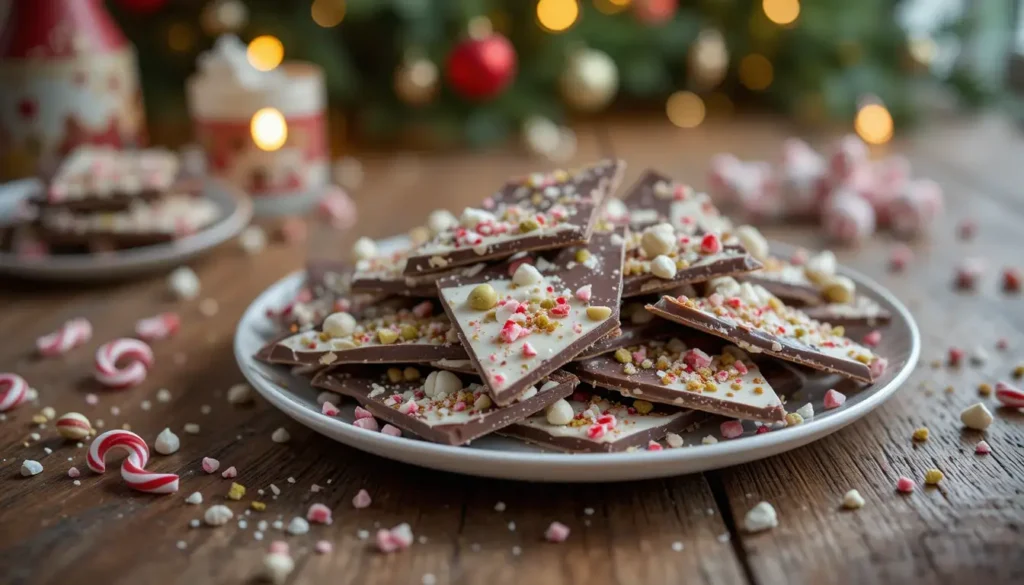When the holiday season rolls around, there’s nothing better than indulging in festive goodies, and Christmas Bark Recipe is at the top of the list. This simple yet crowd-pleasing treat combines the richness of chocolate with an array of delightful toppings, making it a perfect addition to your holiday table. Whether you’re crafting gifts for loved ones, hosting a party, or simply treating yourself, a well-made Christmas Bark Recipe brings joy to every occasion.
So, what makes it so special? Let’s dive into the world of Christmas Bark recipes, their history, and the many ways you can make them your own!
Table of Contents
What Is Christmas Bark?
Christmas Bark is a holiday-inspired dessert made by layering melted chocolate and various toppings, then breaking it into bite-sized pieces. Think of it as the ultimate candy bar, but with a personal, festive twist. From crushed candy canes to nuts, dried fruits, and even pretzels, the possibilities are endless.
A Brief History of Christmas Bark
Although the exact origin of Christmas Bark remains a mystery, its roots are believed to trace back to similar chocolate desserts made in European kitchens centuries ago. Early chocolate barks often featured simple toppings like nuts and dried fruits, which were luxuries during the holiday season. Over time, it evolved into the modern, decorative treat we love today.
Why Christmas Bark Is a Holiday Favorite
What makes Christmas Bark a holiday favorite? For starters, it’s incredibly versatile. You don’t need fancy equipment or advanced culinary skills to create something beautiful and delicious. Plus, it’s one of the most budget-friendly ways to spread cheer. It’s a no-bake dessert, saving you valuable oven space during the busiest baking season of the year.
Ingredients for the Perfect Christmas Bark Recipe
Before diving into the method, gathering the right ingredients for your Christmas Bark Recipe is crucial. The combination of chocolate and toppings is the essence of this festive delight.
Essential Ingredients for the Base
The foundation of Christmas Bark is, of course, chocolate. The type of chocolate you choose plays a significant role in the flavor and texture of your bark. Here are your options:
- Dark Chocolate: For a rich, slightly bitter flavor that pairs well with sweet toppings.
- Milk Chocolate: Perfect for a creamy, sweeter base that kids love.
- White Chocolate: A blank canvas that allows colorful toppings to pop.
Fun and Festive Toppings
Toppings are where your creativity can truly shine. Here are some classic and modern ideas:
- Candy Canes: Crushed peppermint candies add a festive crunch.
- Nuts: Almonds, pistachios, or walnuts provide a satisfying crunch.
- Dried Fruits: Cranberries or cherries lend a sweet and tangy flavor.
- Sprinkles: Holiday-themed sprinkles can make your bark more festive.
- Pretzels: A salty contrast to the sweetness of chocolate.
Substitutes and Allergy-Friendly Options
If you’re making bark for someone with dietary restrictions, there are plenty of alternatives:
- Dairy-Free Chocolate: Use vegan chocolate for lactose-intolerant friends.
- Nut-Free Toppings: Opt for seeds, popcorn, or toasted coconut instead of nuts.
- Low-Sugar Options: Use stevia-sweetened chocolate and skip sugary toppings.
Step-by-Step Guide to Making Christmas Bark
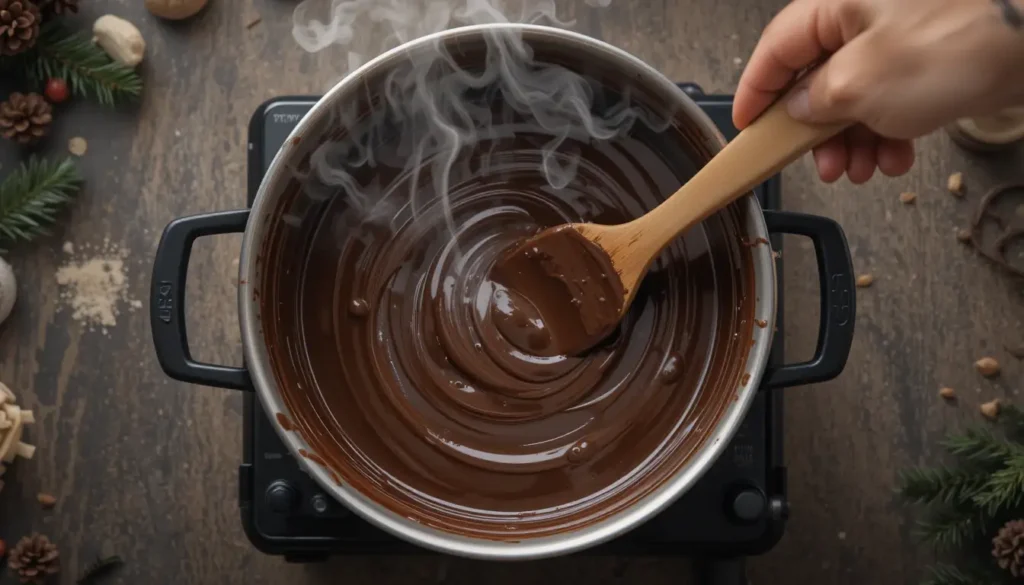
Making Christmas Bark is as easy as one, two, three. Follow these steps to create the perfect batch every time.
Preparing the Ingredients
Begin by gathering all your ingredients and tools. Here’s what you’ll need:
- Baking sheets lined with parchment paper.
- A double boiler or microwave-safe bowl for melting chocolate.
- Spatulas and spoons for spreading and decorating.
Chop your chocolate into small, even pieces if using blocks. This ensures it melts evenly. Organize your toppings into bowls for quick assembly once the chocolate is melted.
Melting the Chocolate
Melting chocolate is the most crucial step in creating smooth, glossy bark. Here’s how to do it:
Double Boiler Method:
- Fill the bottom of a double boiler with water and bring it to a gentle simmer.
- Place the chocolate in the top pan, stirring frequently as it melts.
Microwave Method:
- Place the chocolate in a microwave-safe bowl.
- Heat in 30-second intervals, stirring between each session until fully melted.
Tip: Avoid overheating, as it can cause the chocolate to seize.
Adding Layers and Toppings
- Pour the melted chocolate onto the prepared baking sheet, spreading it evenly with a spatula. Aim for a thickness of about 1/4 inch.
- Sprinkle your chosen toppings over the chocolate while it’s still warm. Be generous but ensure the toppings adhere properly.
Setting and Storing the Bark
Once decorated, allow the chocolate to set completely. You can speed up the process by placing the tray in the refrigerator for about 20 minutes. After it hardens, break the bark into irregular pieces using your hands or a knife.
To store, place the pieces in an airtight container. Keep them in a cool, dry place for up to two weeks or freeze for longer storage.
Popular Variations of Christmas Bark Recipe
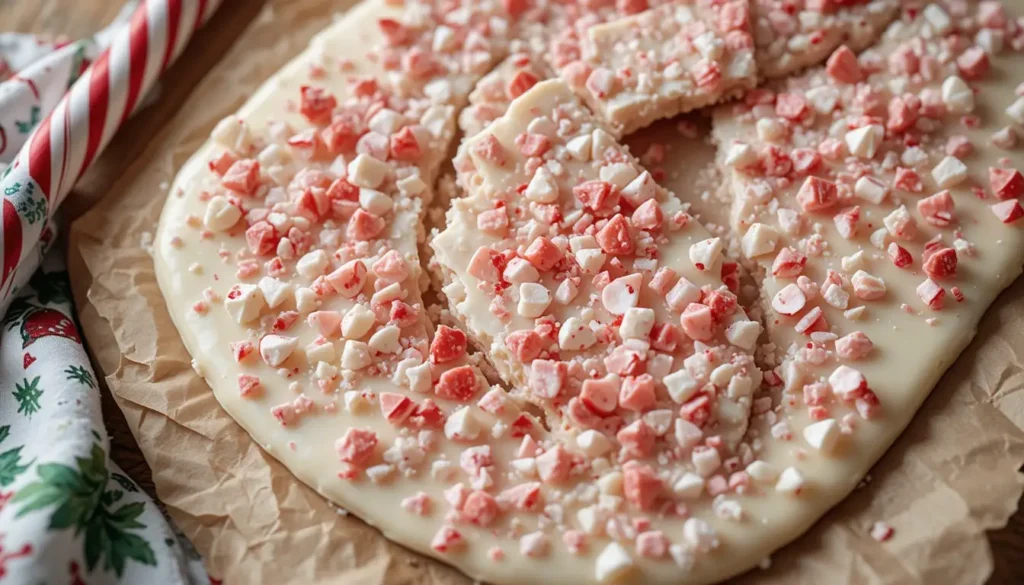
One of the most delightful aspects of making Christmas Bark is its versatility. You can tailor it to suit any taste preference or dietary need. Let’s explore some popular variations that can elevate this holiday treat to a whole new level.
Peppermint Bark: A Minty Delight
Peppermint Bark is arguably the most iconic variation of Christmas Bark. Its cool and refreshing flavor perfectly complements the sweetness of the chocolate, making it a favorite for many holiday enthusiasts.
Here’s how to make it:
- Start with a layer of dark or milk chocolate as the base.
- Add a generous sprinkling of crushed candy canes or peppermint candies.
- For an extra festive touch, drizzle melted white chocolate over the top.
This variation pairs wonderfully with a hot cup of cocoa or coffee, enhancing the holiday vibes.
Nutty and Crunchy Bark Variations
For those who love a little crunch, nut-based Christmas Bark is the way to go. Nuts add both texture and a toasty, earthy flavor that complements the creaminess of chocolate.
Try these combinations:
- Almond Bark: Use roasted almonds and sprinkle a pinch of sea salt for a gourmet twist.
- Pistachio-Cranberry Bark: Pair the vibrant green of pistachios with the tartness of dried cranberries for a visually stunning treat.
- Peanut Butter Swirl Bark: Add dollops of peanut butter and swirl it through the melted chocolate before it sets.
Healthy and Vegan-Friendly Options
If you’re catering to health-conscious or vegan guests, you can still create a delicious Christmas Bark.
Here’s how:
- Use dairy-free chocolate or dark chocolate with a high cocoa percentage.
- Swap sugary toppings for superfoods like goji berries, chia seeds, or toasted coconut flakes.
- Drizzle almond butter or tahini for a creamy, nutrient-rich addition.
These options not only taste amazing but also look vibrant and inviting on any dessert table.
Troubleshooting Common Problems with Christmas Bark
Even with such a simple recipe, things can occasionally go wrong. Don’t worry—every problem has a solution. Here are some common issues you might encounter while making Christmas Bark and how to fix them.
Why Does Chocolate Bloom and How to Prevent It?
Chocolate bloom appears as white streaks or spots on the surface of your bark. This happens when the chocolate hasn’t been tempered correctly, causing the fats or sugars to rise to the surface.
To prevent bloom:
- Melt chocolate slowly at low temperatures.
- Stir constantly while melting to maintain an even consistency.
- If tempering chocolate feels daunting, use candy melts or pre-tempered chocolate for a foolproof alternative.
Fixing Texture Issues: Too Soft or Too Hard
Sometimes, the bark might end up too soft or rock-hard, which can make it less enjoyable to eat.
- Too Soft: This often happens if the chocolate wasn’t set properly. Allow it to cool in the refrigerator until it hardens completely.
- Too Hard: Overheating chocolate can lead to a brittle texture. In this case, add a small amount of coconut oil during melting to improve the texture.
Preventing Topping Sinking or Sliding
If your toppings sink into the chocolate or slide off after it sets, here’s what to do:
- Add toppings immediately after spreading the melted chocolate to ensure they adhere properly.
- Press toppings gently into the chocolate using the back of a spoon to secure them.
Creative Ways to Serve and Gift Christmas Bark
Christmas Bark isn’t just delicious—it’s also a fantastic gift or party treat. Let’s explore some fun and creative ways to share this holiday favorite.

Decorative Wrapping Ideas
Turn your Christmas Bark into a thoughtful gift with some decorative wrapping. Here are a few ideas:
- Use clear cellophane bags tied with festive ribbons.
- Place bark pieces in holiday-themed tins or mason jars for a rustic touch.
- Add handwritten tags with a personal note or the recipe for a meaningful touch.
Pairing Bark with Other Holiday Treats
Create a stunning dessert platter by pairing Christmas Bark with other holiday goodies like cookies, fudge, or truffles. You can even include savory snacks like cheese and crackers to create a balanced spread.
Hosting a DIY Bark-Making Party
Why not make the creation of Christmas Bark a social event? Hosting a DIY bark-making party can be a fun way to gather friends and family.
- Set up a “bark bar” with various chocolates and toppings.
- Let everyone customize their own bark creations.
- Provide decorative bags so guests can take their treats home as party favors.
Tips for Storing and Preserving Christmas Bark
To enjoy your Christmas Bark at its best, proper storage is key. Follow these tips to keep it fresh and delicious for as long as possible.
Shelf Life of Christmas Bark
Christmas Bark typically lasts up to two weeks when stored in an airtight container at room temperature. If you live in a warmer climate, consider refrigerating it to prevent melting.
Best Practices for Packaging
If you’re giving bark as a gift or storing it for later, packaging matters:
- Use parchment paper to separate layers of bark in containers to prevent sticking.
- Choose festive tins or resealable plastic bags to keep it airtight.
- Label your packages with the storage instructions, especially if the bark contains perishable toppings like fresh fruit.
Healthier Twists on Christmas Bark Recipe
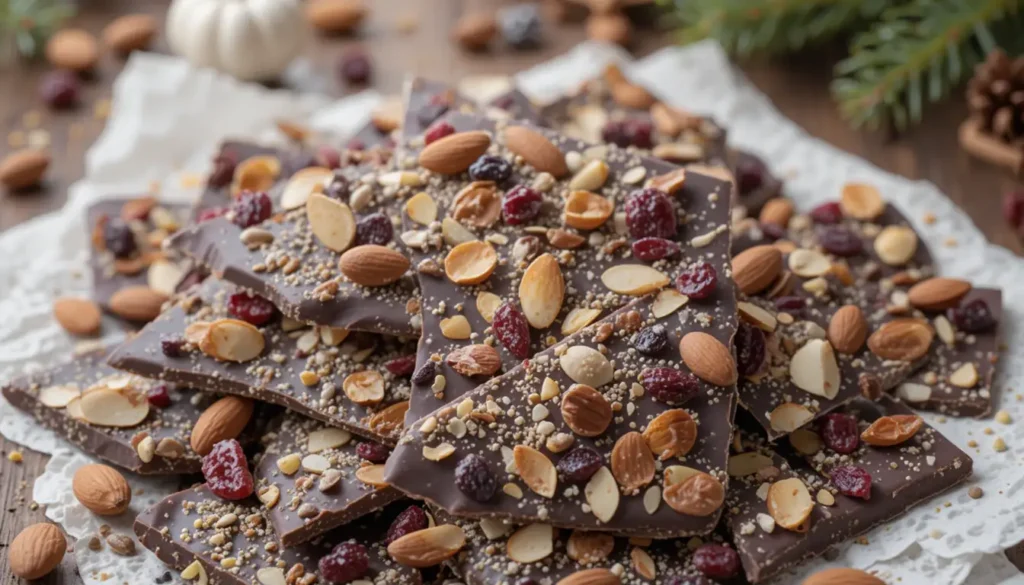
While Christmas Bark is already a treat worth savoring, you can add a healthy spin to it without compromising on taste. Whether you’re looking to cut down on sugar or boost its nutritional value, these twists will give your festive dessert a guilt-free makeover.
Low-Sugar Options
For those mindful of their sugar intake, there are plenty of ways to enjoy Christmas Bark:
- Sugar-Free Chocolate: Opt for stevia-sweetened or sugar-free chocolate chips as your base.
- Natural Sweeteners: Incorporate honey, maple syrup, or agave as subtle sweetening agents. A drizzle over the bark can add flavor and decoration in one go.
- Fresh vs. Dried Fruits: Use fresh berries or unsweetened dried fruits to keep the sugar content in check.
These substitutions ensure that the bark stays festive and delicious without becoming overly indulgent.
Incorporating Superfoods
Why not turn your Christmas Bark into a powerhouse of nutrition? Adding superfoods can make it both delicious and beneficial to your health:
- Chia Seeds: Sprinkle chia seeds for a boost of omega-3s and fiber.
- Goji Berries: Their tart flavor complements dark chocolate beautifully while providing antioxidants.
- Pumpkin Seeds: Add a festive green touch while packing in protein and essential minerals.
Superfood bark doesn’t just taste good—it also leaves you feeling good about indulging in a holiday treat.
Why Christmas Bark Is the Perfect Holiday Gift
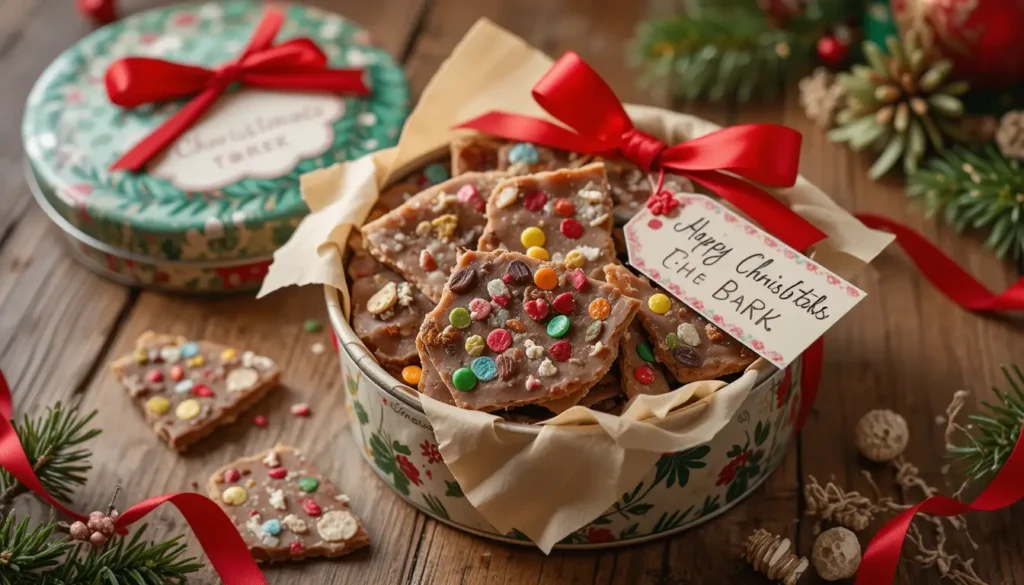
If you’ve ever struggled to find the ideal holiday gift, Christmas Bark might just be your solution. This versatile dessert checks all the boxes—it’s thoughtful, delicious, and easy to customize.
Affordable and Personal
Unlike store-bought treats, homemade Christmas Bark is incredibly affordable, allowing you to create multiple gifts without breaking the bank. The best part? It’s highly personal. You can tailor each batch to the recipient’s tastes, ensuring they know you made it with them in mind.
For example:
- Add their favorite toppings like peanut butter cups or espresso beans.
- Use themed packaging that aligns with their style—think rustic jars for minimalists or glittery bags for those who love glam.
Customizable to Suit Any Taste
The beauty of Christmas Bark lies in its adaptability. You can create endless flavor combinations to cater to anyone’s preferences or dietary restrictions. Here are some ideas:
- For Kids: Milk chocolate with marshmallows, colorful sprinkles, and gummy candies.
- For Gourmet Lovers: Dark chocolate with roasted hazelnuts, fleur de sel, and edible gold flakes.
- For Health Enthusiasts: Vegan chocolate with nuts, seeds, and unsweetened coconut flakes.
This level of customization ensures your gift feels truly special.
FAQs About Christmas Bark Recip
If you’re new to making Christmas Bark, you may have a few questions. Here are some of the most common inquiries and helpful answers.
Can You Freeze Christmas Bark?
Absolutely! Freezing Christmas Bark is a great way to extend its shelf life. Wrap the pieces in parchment paper and store them in an airtight container or freezer bag. It can last up to three months in the freezer. Just thaw it at room temperature before serving.
What Is the Best Chocolate to Use?
The quality of chocolate can make or break your bark. Always use high-quality chocolate with a cocoa content of 60% or higher for dark chocolate. For milk or white chocolate, choose brands that melt smoothly and have a creamy texture.
How Far in Advance Can You Make It?
Christmas Bark can be made up to two weeks in advance if stored properly in an airtight container. If you’re adding perishable toppings like fresh fruit, aim to make it no more than a day or two ahead.
Can You Use White Chocolate Only?
Yes! White chocolate is a popular choice for Christmas Bark because it allows toppings like cranberries and pistachios to stand out. Just ensure you use high-quality white chocolate to avoid issues with melting or setting.
How Do You Add Unique Flavors to Bark?
Experimenting with extracts, spices, and zests is the key to creating unique flavors. Add peppermint extract for a minty twist, orange zest for citrus notes, or a sprinkle of cinnamon for warmth.
Conclusion: Create Joy with Christmas Bark
Christmas Bark Recipe is more than just a dessert—it’s a way to spread holiday cheer and connect with loved ones. Its simplicity, versatility, and charm make it a favorite treat for people of all ages. Whether you’re making a Christmas Bark Recipe for your family, gifting it to friends, or serving it at a festive party, this recipe guarantees smiles and satisfied taste buds.
So, this holiday season, roll up your sleeves, get creative with your toppings, and enjoy the process of crafting this delicious treat. With every batch, you’re not just making bark—you’re making memories that will last long after the holidays are over.
Happy Bark-Making!
For more Christmas recipes check this Christmas Chex Mix Recipe

